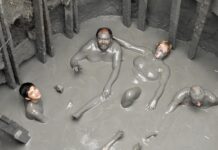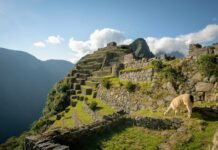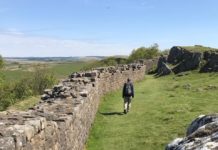
by Jay Vogt
Camino Frances pilgrims may begin in Paris, or in various places in France, but most start at one of two towns on either side of the border between France and Spain.
I walked the 764 km (about 475 miles) from Roncesvalles, Spain to Santiago in April and May of 2012. I took about thirty days, plus rest stops. The route is divided by one popular guidebook into 32 stages, each averaging 24 km (about 15 miles) per day. I then walked beyond Santiago to Finisterre (in Latin “land’s end”) where pilgrims traditionally swim in the Atlantic Ocean, burn their clothes, and find a scallop shell to bring home as proof of their success in completing the pilgrimage.
While The Camino Frances can make for a perfect walking vacation, there are several ways that a pilgrimage differs from what most people think of when you mention “vacation.”
So, how is a pilgrimage different from a walking holiday?
One answer is that the Spanish people are supporting your success every step of the way, almost like spectators cheering on runners at a marathon. Many a Spaniard salutes you as you walk, saying “Buen Camino,” blessing pilgrims as their parents have and their grandparents before them. When you wander off the path, inevitably some kind stranger speaks up, and guides you back. Pilgrims carrying a proper credential are given special places to stay, and discounts on food and fees. Catholic priests say special masses in your honour, and give you their personal blessing. Sometimes it seems the whole society living along the Camino is dedicated to helping you make your way to Santiago.
Another answer is that an engaging community of pilgrims grows along the path, all sharing the same destination, all supporting each other, each discovering remarkable reasons why they have encountered one another along the way. There are stories to tell, meals to share, and adventures to have, with strangers who soon feel like old friends, sharing an emotional intimacy that for many embodies the essence of the Camino. A veritable United Nations of spiritual seekers gathers along this path to walk beside you.
A third response would be your own intention. One pilgrim walks because both his parents and wife died in the last year, and he grieves and heals step by step. Another just had colon cancer surgery and, foregoing chemotherapy, walks for a cure. Others are experiencing transition between jobs, or walking with a major life question to be answered. Should I leave my steady job and start a business? Which medical school community shall I choose for the next six years of my life? The motivations are as diverse as the pilgrims themselves.
I walk to honour the ancient and sacred tradition of pilgrimage itself; to complete an act of devotion to something greater than myself that I can’t accomplish alone; to cleanse and revitalize myself in the energy built up over a thousand years of pilgrimage; to experience the simple joy of walking; and to wonder at new lands, people, and experiences.
The rhythm of a pilgrim’s day begins with packing up one’s things and preparing for the road. Many start about seven or so, most commonly to find coffee and a light breakfast. Then begins the day’s walking, at your own pace, either alone, or with a new or old friend. The path underfoot may be earth, crushed stone, or asphalt. The scenery may be breathtaking, or entirely nondescript. Ever present yellow arrows guide you reassuringly along your way.
A typical pilgrim breakfast is café con leche, or coffee with hot milk, and perhaps freshly squeezed orange juice, with toast or pastry, or a slice of tortilla, a thick omelet of eggs, onions, and potato. The pilgrim lunch, or menu del dia in Spanish, is a three-course meal that could include soup, paella or salad, followed by chicken, pork or fish as the entree and ending with flan, rice pudding or fruit. Even a solo traveler gets a full bottle of wine with lunch. Evening dinners feature a dazzling array of tapas, including anchovies, quail eggs, potato salad, and eel. Wine, beer, water or soda accompany the meals.
Most pilgrims stay in albergues, simple dormitory style lodgings offering basic facilities, and costing between 5 and 10 Euros a night (about $6 to $12 U.S.) Many towns have several to choose from, ranging from dingy to sublime. Some hostels are run by towns, some by churches, and others by volunteers. They are an economical and effortless source of community, but bring your own sleeping bag, towel and ear plugs to guard against the ever present snoring at night. Some pilgrims happily prefer small pensions and hotels, paying a higher price to enjoy great privacy and quiet.
Your choice in lodging is one of many you make in creating your own personal Camino, and every choice is okay. Most pilgrims walk, but many bicycle, some go by bus, and some even run. Most walk every step, but others take taxis and buses to cut out industrial sections. Most carry their own backpacks, but some hire services to transport their luggage for a fee. Many start the Camino Frances on the border, but others start in Leon, O’Cebrerio, Sarria, or other towns along the way. Some walk alone, but others walk with new or old friends, or in organized groups. There are many ways to do the Camino, and each has merit. In order to receive an official compostela from the Catholic Church, however, signifying successful completion of your pilgrimage, you must walk the last 100 kilometers from Sarria, or bike the last 200 kilometers.
Five Lessons
It is hard to put into words all the blessings I received, but here are five lessons that came home with me:
1. Listen to your body. Many people hurt themselves on the Camino, because it is demanding. Paying close attention to your body’s needs helps prevent injury.
2. Be grateful for kindness. The kindness of the Spaniards, the hospitaleros, and fellow pilgrims is staggering. Receive it, and give thanks.
3. Share kindness freely. We create the Camino experience of others. Even small acts of generosity can make a huge difference to others.
4. Embrace community. The Camino is a rare opportunity to meet and learn from spiritual seekers from all over the world.
5. Make time for solitude. The Camino can be a very social experience, and yet it is ultimately a time for personal reflection and renewal.
The Camino Frances is not only an honored UNESCO World Heritage Route, but it is a living cultural treasure, and offers pilgrims a deeply affecting personal, physical, and spiritual experience.
~ ~ ~ ~ ~
When not walking, Jay W Vogt is President of Peoplesworth, a consulting practice, and author of Recharge Your Team: The Grounded Visioning Approach. Contact him at jay@peoplesworth.com











